Abstract
The purpose of this paper is to review the known and possible homologies between mouse and human multiple congenital anomaly syndromes. By identifying single gene defects causing similar developmental abnormalities in mouse and man, comparative gene mapping can be carried out, and if the loci in mouse and man are situated in homologous chromosome segments, further molecular studies can be performed to show that the loci are identical. This paper puts forward tentative homologies in the hope that some will be investigated and shown to be true homologies at the molecular level, thus providing mouse models for complex developmental syndromes. The mouse malformation syndromes are reviewed according to their major gene effects. X linked syndromes are reviewed separately because of the greater ease of establishing homology for these conditions.
Full text
PDF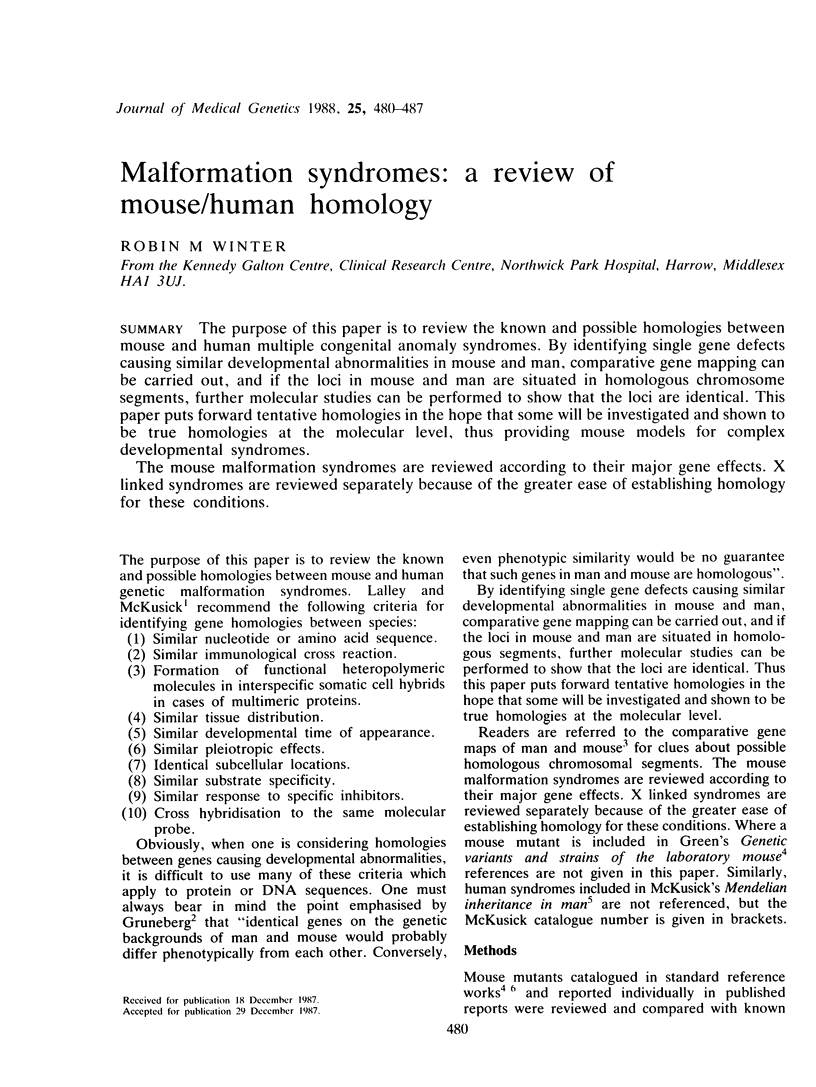
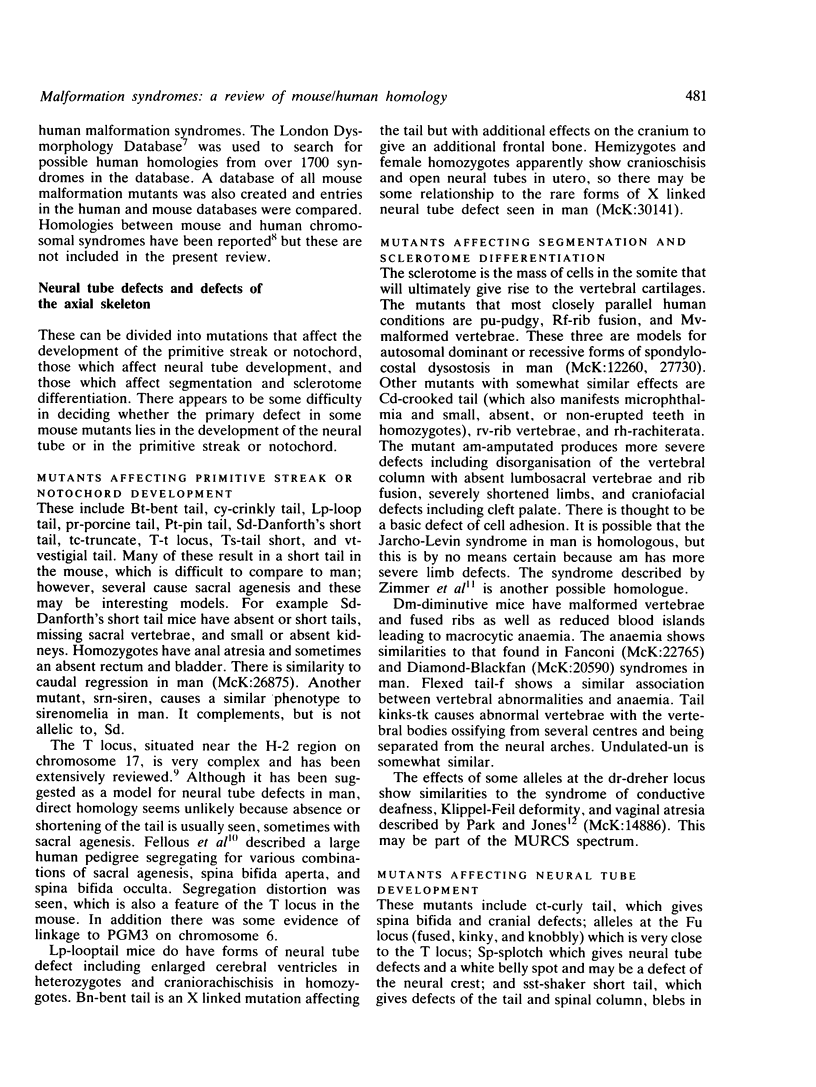
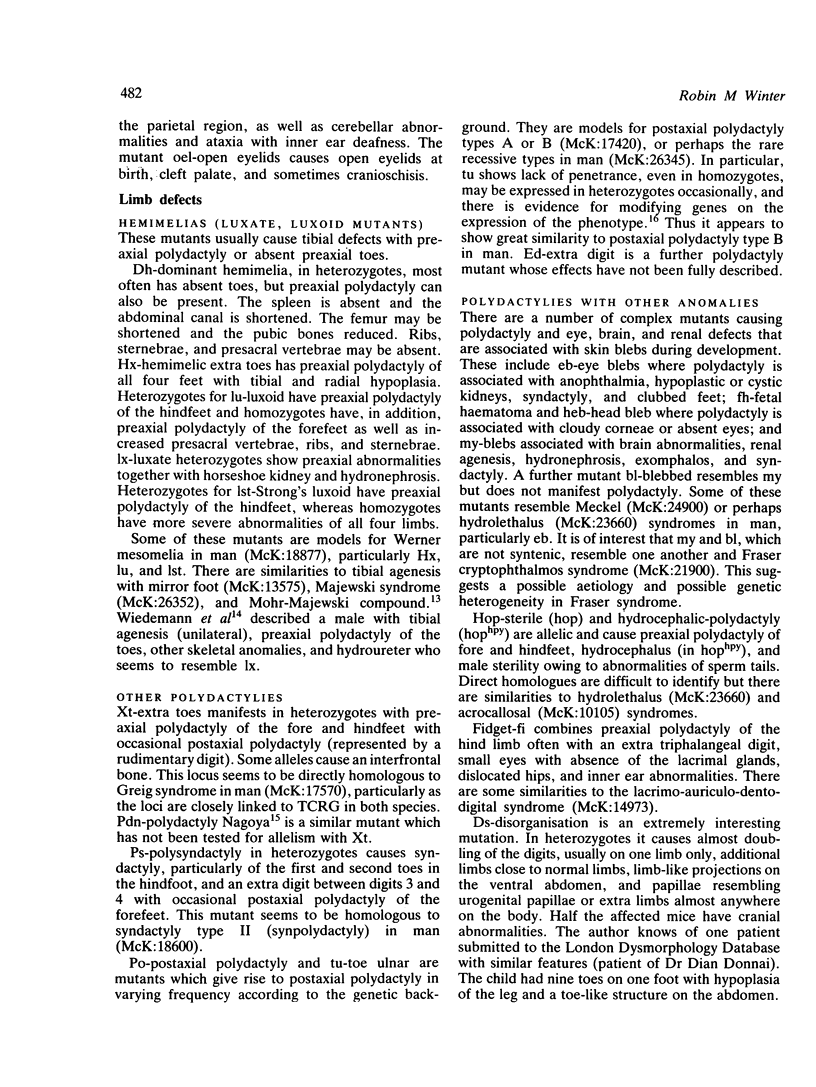
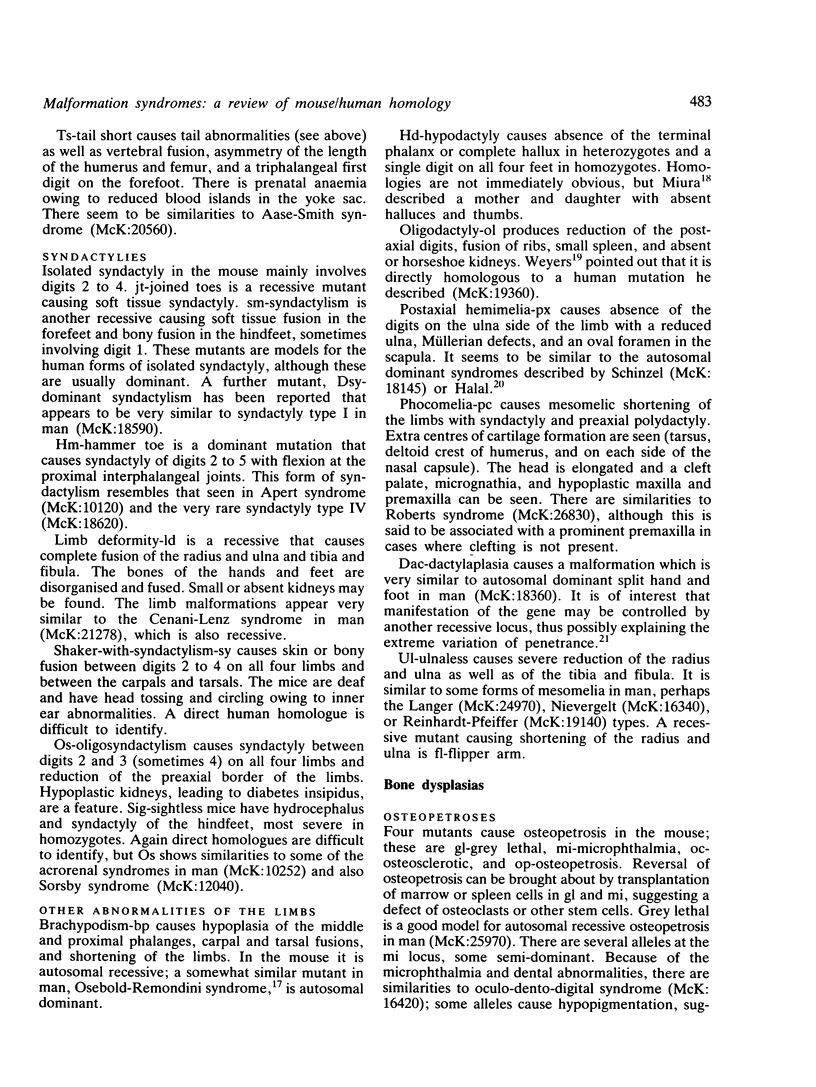
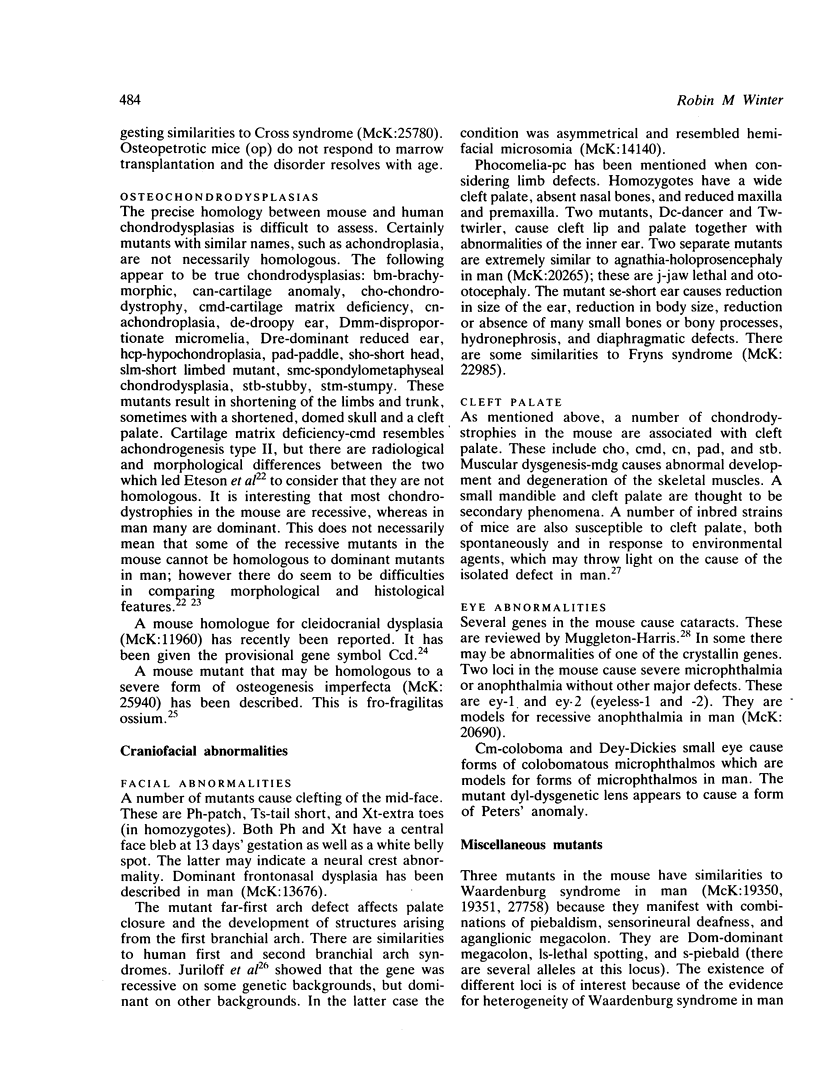
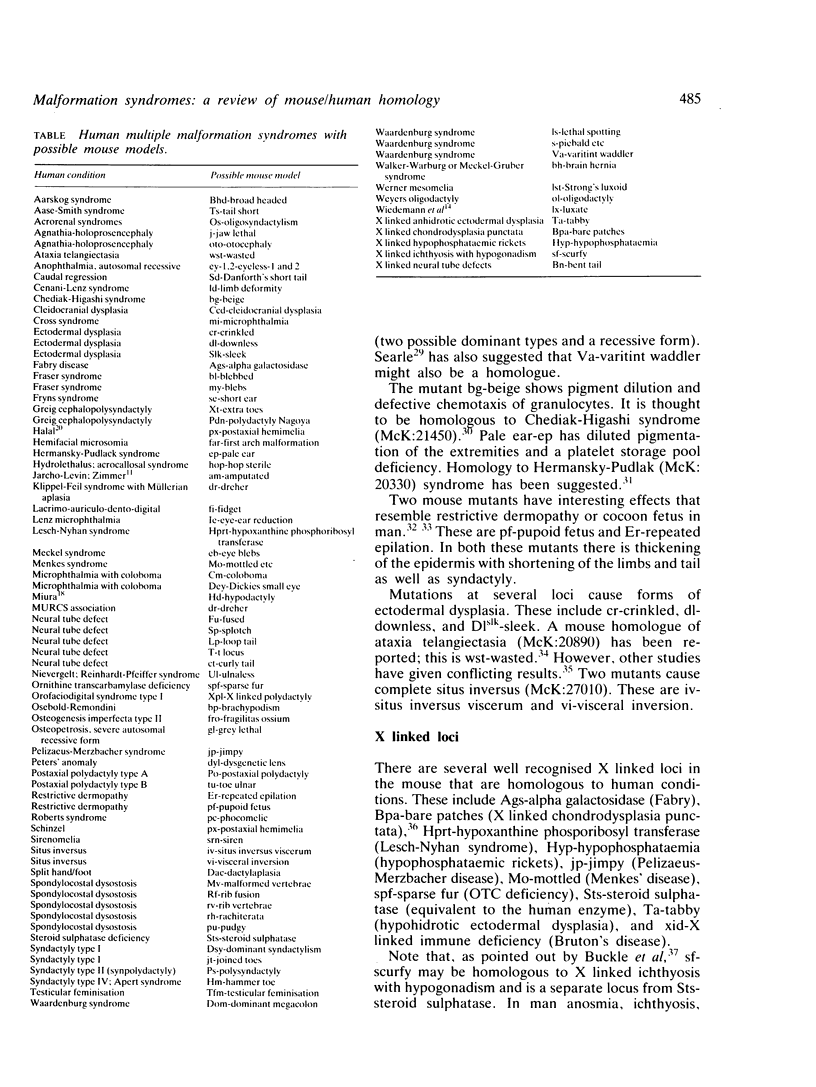
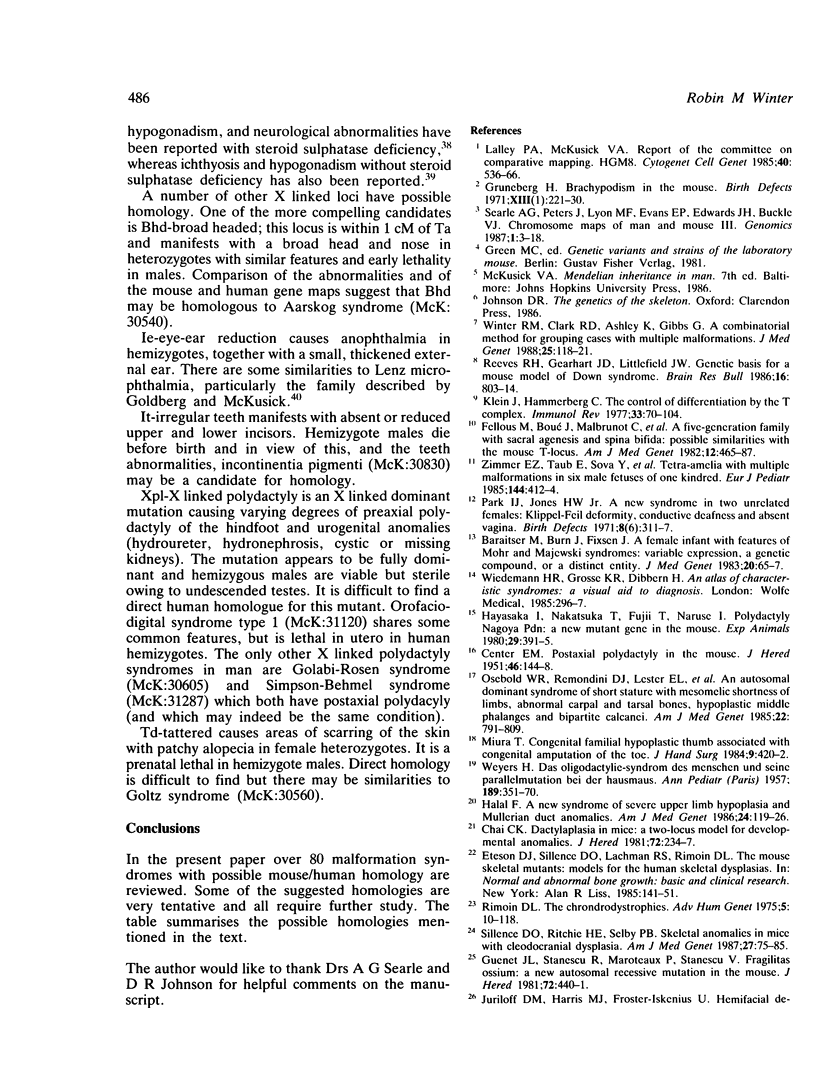
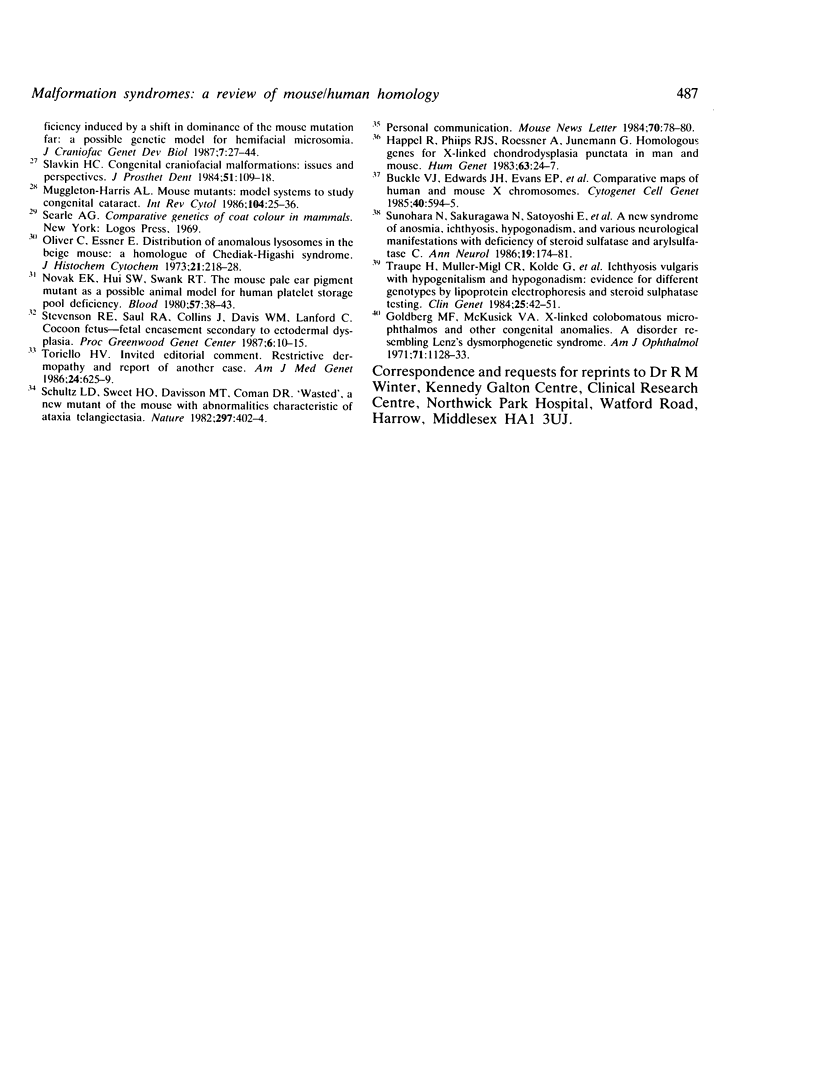
Selected References
These references are in PubMed. This may not be the complete list of references from this article.
- Baraitser M., Burn J., Fixsen J. A female infant with features of Mohr and Majewski syndromes: variable expression, a genetic compound, or a distinct entity? J Med Genet. 1983 Feb;20(1):65–67. doi: 10.1136/jmg.20.1.65. [DOI] [PMC free article] [PubMed] [Google Scholar]
- Chai C. K. Dactylaplasia in mice a two-locus model for development anomalies. J Hered. 1981 Jul-Aug;72(4):234–237. doi: 10.1093/oxfordjournals.jhered.a109486. [DOI] [PubMed] [Google Scholar]
- Eteson D. J., Sillence D. O., Lachman R. S., Rimoin D. L. The mouse skeletal mutants: models for the human skeletal dysplasias. Prog Clin Biol Res. 1985;187:141–151. [PubMed] [Google Scholar]
- Fellous M., Boué J., Malbrunot C., Wollman E., Sasportes M., Van Cong N., Marcelli A., Rebourcet R., Hubert C., Demenais F. A five-generation family with sacral agenesis and spina bifida: possible similarities with the mouse T-locus. Am J Med Genet. 1982 Aug;12(4):465–487. doi: 10.1002/ajmg.1320120410. [DOI] [PubMed] [Google Scholar]
- Goldberg M. F., McKusick V. A. X-linked colobomatous microphthalmos and other congenital anomalies. A disorder resembling Lenz's dysmorphogenetic syndrome. Am J Ophthalmol. 1971 May;71(5):1128–1133. doi: 10.1016/0002-9394(71)90588-5. [DOI] [PubMed] [Google Scholar]
- Guenet J. L., Stanescu R., Maroteaux P., Stanescu V. Fragilitas ossium: a new autosomal recessive mutation in the mouse. J Hered. 1981 Nov-Dec;72(6):440–441. doi: 10.1093/oxfordjournals.jhered.a109554. [DOI] [PubMed] [Google Scholar]
- Halal F. A new syndrome of severe upper limb hypoplasia and Müllerian duct anomalies. Am J Med Genet. 1986 May;24(1):119–126. doi: 10.1002/ajmg.1320240114. [DOI] [PubMed] [Google Scholar]
- Happle R., Phillips R. J., Roessner A., Jünemann G. Homologous genes for X-linked chondrodysplasia punctata in man and mouse. Hum Genet. 1983;63(1):24–27. doi: 10.1007/BF00285392. [DOI] [PubMed] [Google Scholar]
- Hayasaka I., Nakatsuka T., Fujii T., Naruse I., Oda S. Polydactyly Nagoya, Pdn: A new mutant gene in the mouse. Jikken Dobutsu. 1980 Oct;29(4):391–395. doi: 10.1538/expanim1978.29.4_391. [DOI] [PubMed] [Google Scholar]
- Juriloff D. M., Harris M. J., Froster-Iskenius U. Hemifacial deficiency induced by a shift in dominance of the mouse mutation far: a possible genetic model for hemifacial microsomia. J Craniofac Genet Dev Biol. 1987;7(1):27–44. [PubMed] [Google Scholar]
- Klein J., Hammerberg C. The control of differentiation by the T complex. Immunol Rev. 1977 Jan;33:70–104. doi: 10.1111/j.1600-065x.1977.tb00363.x. [DOI] [PubMed] [Google Scholar]
- Lalley P. A., McKusick V. A. Report of the Committee on Comparative Mapping. Cytogenet Cell Genet. 1985;40(1-4):536–566. doi: 10.1159/000132187. [DOI] [PubMed] [Google Scholar]
- Novak E. K., Hui S. W., Swank R. T. The mouse pale ear pigment mutant as a possible animal model for human platelet storage pool deficiency. Blood. 1981 Jan;57(1):38–43. [PubMed] [Google Scholar]
- Oliver C., Essner E. Distribution of anomalous lysosomes in the beige mouse: a homologue of Chediak-Higashi syndrome. J Histochem Cytochem. 1973 Mar;21(3):218–228. doi: 10.1177/21.3.218. [DOI] [PubMed] [Google Scholar]
- Osebold W. R., Remondini D. J., Lester E. L., Spranger J. W., Opitz J. M. An autosomal dominant syndrome of short stature with mesomelic shortness of limbs, abnormal carpal and tarsal bones, hypoplastic middle phalanges, and bipartite calcanei. Am J Med Genet. 1985 Dec;22(4):791–809. doi: 10.1002/ajmg.1320220414. [DOI] [PubMed] [Google Scholar]
- Reeves R. H., Gearhart J. D., Littlefield J. W. Genetic basis for a mouse model of Down syndrome. Brain Res Bull. 1986 Jun;16(6):803–814. doi: 10.1016/0361-9230(86)90076-6. [DOI] [PubMed] [Google Scholar]
- Rimoin D. L. The chondrodystrophies. Adv Hum Genet. 1975;5:1–118. doi: 10.1007/978-1-4615-9068-2_1. [DOI] [PubMed] [Google Scholar]
- Searle A. G., Peters J., Lyon M. F., Evans E. P., Edwards J. H., Buckle V. J. Chromosome maps of man and mouse, III. Genomics. 1987 Sep;1(1):3–18. doi: 10.1016/0888-7543(87)90099-1. [DOI] [PubMed] [Google Scholar]
- Shultz L. D., Sweet H. O., Davisson M. T., Coman D. R. 'Wasted', a new mutant of the mouse with abnormalities characteristic to ataxia telangiectasia. Nature. 1982 Jun 3;297(5865):402–404. doi: 10.1038/297402a0. [DOI] [PubMed] [Google Scholar]
- Sillence D. O., Ritchie H. E., Selby P. B. Animal model: skeletal anomalies in mice with cleidocranial dysplasia. Am J Med Genet. 1987 May;27(1):75–85. doi: 10.1002/ajmg.1320270109. [DOI] [PubMed] [Google Scholar]
- Slavkin H. C. Congenital craniofacial malformations: issues and perspectives. J Prosthet Dent. 1984 Jan;51(1):109–118. doi: 10.1016/s0022-3913(84)80116-x. [DOI] [PubMed] [Google Scholar]
- Sunohara N., Sakuragawa N., Satoyoshi E., Tanae A., Shapiro L. J. A new syndrome of anosmia, ichthyosis, hypogonadism, and various neurological manifestations with deficiency of steroid sulfatase and arylsulfatase C. Ann Neurol. 1986 Feb;19(2):174–181. doi: 10.1002/ana.410190211. [DOI] [PubMed] [Google Scholar]
- Toriello H. V. Restrictive dermopathy and report of another case. Am J Med Genet. 1986 Aug;24(4):625–629. doi: 10.1002/ajmg.1320240407. [DOI] [PubMed] [Google Scholar]
- Traupe H., Müller-Migl C. R., Kolde G., Happle R., Kövary P. M., Hameister H., Ropers H. H. Ichthyosis vulgaris with hypogenitalism and hypogonadism: evidence for different genotypes by lipoprotein electrophoresis and steroid sulfatase testing. Clin Genet. 1984 Jan;25(1):42–51. doi: 10.1111/j.1399-0004.1984.tb00461.x. [DOI] [PubMed] [Google Scholar]
- WEYERS H. Das Oligodactylie-Syndrom des Menschen und seine Parallelmutation bei der Hausmaus; ein Anomaliekomplex mit Ulnaaplasie, Reduktion der ulnaren Randstrahlen, Zwischenkiefer-, Sternum-, Nieren- und Milzanomalien. Ann Paediatr. 1957 Dec;189(6):351–370. [PubMed] [Google Scholar]
- Winter R. M., Clark R. D., Ashley K., Gibbs G. A combinatorial method for grouping cases with multiple malformations. J Med Genet. 1988 Feb;25(2):118–121. doi: 10.1136/jmg.25.2.118. [DOI] [PMC free article] [PubMed] [Google Scholar]
- Zimmer E. Z., Taub E., Sova Y., Divon M. Y., Pery M., Peretz B. A. Tetra-amelia with multiple malformations in six male fetuses of one kindred. Eur J Pediatr. 1985 Nov;144(4):412–414. doi: 10.1007/BF00441792. [DOI] [PubMed] [Google Scholar]


